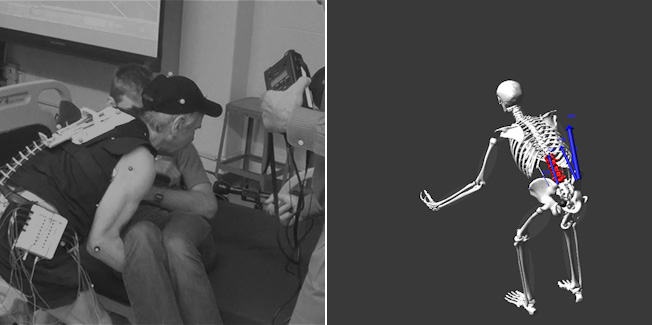Zwerdling Wins March Sidney for Exposing Nursing’s Back Injury Crisis
Daniel Zwerdling of National Public Radio’s “All Things Considered” wins the March Sidney Award for “Injured Nurses,” a four-part series that reveals the shockingly high rate of crippling back injuries among nurses in the face of widespread indifference by hospitals.
Nurses, nursing assistants, and orderlies suffer more disabling back injuries on the job than any other class of workers, including police officers and construction workers. Over 35,000 nursing staffers hurt their backs badly enough to miss work every year, with many sustaining permanent, disabling injuries.
Zwerdling’s investigation revealed why these injuries are so common: Lifting patients is big part of hospital nursing, and standard operating procedure for lifting is inherently dangerous. Biomechanics experiments prove that when nurses lift by the rules, they silently damage their spines on every shift.
Hospitals could solve this problem by providing enough mechanical lifts and trained lifting assistants, but few are willing to spend the money, perhaps because nurses are considered disposable labor.
Court records and internal hospital documents obtained by Zwerdling showed that hospital officials routinely ignored evidence that the everyday work of nursing was crippling their employees. Emails showed that administrators at a major hospital were denying that nurses’ back injuries were caused on the job, even though the medical staff said they were.
“It’s ironic that the nation’s finest hospitals are among the country’s most dangerous workplaces,” said Sidney judge Lindsay Beyerstein, “Nurses take care of us, but nobody is taking care of them.”
Daniel Zwerdling is a correspondent in NPR’s Investigations Unit. With acclaimed investigative and documentary reports appearing on all of NPR’s major news shows, Zwerdling’s stories have repeatedly attracted national attention and generated national action. He’s won every major broadcasting award, including the DuPont, Peabody, Polk and Edward R. Murrow.

Backstory
Q: How did you become aware that back injuries were such a big problem for nurses?
A: I was having a coffee with a couple top officials at OSHA, and one said, “Did you know that nursing employees have more back and arm injuries than almost any other occupation, according to the Bureau of Labor Statistics – and those injuries are caused mainly by lifting and moving patients?” At first, actually, I didn’t find that particularly interesting or troubling. I figured, “So, you pull a muscle and miss a day’s work or whatever – it’s not exactly a tragedy.”
But then I started digging past the statistics: I tracked down and met injured nurses and nurses’ assistants from Pennsylvania to California. I saw their x-rays, saw the huge metal plates and screws that surgeons had to fasten around their spines. I heard their husbands describe, crying in some cases, how their wives’ debilitating injuries from lifting and moving patients had ended their wives’ careers and changed both their lives. Medical staff in hospitals told me how top managers were neglecting or even covering up nursing injuries, because they didn’t want to spend the money to prevent them. We got federal and state records under the Freedom of Information Act, and found that government regulators hardly ever crack down on hospitals which have high rates of injuries among nursing staff, caused by lifting patients. And I began to realize that injuries among nursing staff are one of the most damaging and little-recognized national epidemics.
Q: Nurses are taught “correct” body positioning that supposedly enables them to move patients safely without lifts. How do we know that the recommended procedures don’t work?
Officials at hospitals and nursing schools told us that they they’ve been teaching correct “body mechanics” to nursing staff for eons – yet federal surveys keep showing that nursing employees suffer more back and arm injuries from moving and lifting patients than almost any other occupation. So, obviously, the lessons aren’t working. Plus, scientists at Ohio State University have used sophisticated electronic sensors to study what happens inside the backs of actual nursing employees when they move and lift patients, and those studies show that the magnitude of forces on the employees’ backs is greater than anything they’ve seen on factory assembly lines – and above the thresholds that cause injuries.
Q: What are some of the ways that hospitals try to avoid responsibility for the safety of nurses when it comes to lifting patients?
A: Every hospital administrator my colleagues and I interviewed assured us that their employees’ safety and health is one of their top priorities. Yet, when we asked them to show us the logs they have to keep under federal law that track employee injuries, they ignored our requests or refused. Still, we obtained internal files from two major hospitals, on opposite sides of the country, showing that nursing employees were repeatedly injured by moving and lifting patients. We got internal emails from one of those hospitals, showing that a top doctor warned hospital administrators that they kept mistreating their employees – by insisting that their injuries were not caused on the job, even though the medical staff said they were.
Q: You spoke to a senior hospital lobbyist who seemed to downplay the threat of back injuries in nursing. Does the industry have a vested interest in ignoring the problem?
A: This is one of the issues that kept puzzling me, and I spent a huge amount of time talking to hospital industry researchers and managers in an effort to figure it out. The insurance industry itself declares that hospitals pay more workers compensation for nursing employees who get injured by lifting and moving patients than for any other injury. Hospitals also spend large amounts of money on medical care for injured nursing staff, and to hire temp staff to replace them. So why wouldn’t every hospital do everything possible to prevent lifting injuries – an approach that, some hospitals have discovered, can actually end up saving money over years? The main answer has two parts: first, hospital administrators are preoccupied with other spending priorities – especially ones that affect reimbursements, such as infection control, and programs like computerizing records, which is required under the law. Second, hospital executives have historically devalued nursing staff, according to just about every industry researcher we talked to (and according to some former hospital executives themselves).
Q: How is the VA working to protect nurses from back injuries on the job?
A: We were astonished to learn that while the media have been reporting mainly negative news about the VA – important news, about vets waiting months for important appointments, and occasionally getting inadequate care – the VA has quietly been doing something striking: it has done more than perhaps any other hospital system to reduce the number of staff injuries caused by lifting patients. At some VA hospitals, such as one I visited in Loma Linda, CA, they’ve spent millions of dollars to install motorized ceiling lifts to move patients in every patient room and clinic – which, researchers say, is one of the most important strategies for protecting staff. Some VA hospitals have reduced injuries by 80 percent, according to the VA’s studies, and the system has reduced injuries nationwide by about 40 percent.


